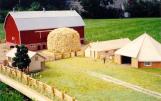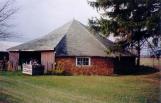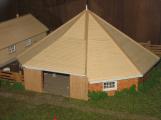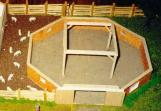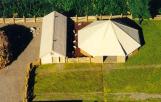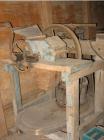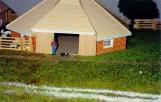1
Let's proceed to the unusual, eight-sided Octagon Implement Shed.3
The shed was constructed in the summer of 1918.5
The bricks used were purchased from the Presbyterian Church in Alliston. The bricks had been slated to be used in the building of the new Church, but the congregation then decided to use pressed brick instead, and sold these bricks to Thompson and Nelson Banting.7
The shed was designed specifically to make the implements easier to access. Traditional driving sheds are rectangular. As you finish working with a seasonal piece of farm machinery, you put it in the shed, followed by the next, and then another. Autumn equipment blocks access to Spring equipment. With the octagon shed, machinery is placed around the interior wall and you can just drive in and remove whatever unobstructed piece you need.9
Marie (Banting) Shields notes that, with this design, "[t]hey didn't have to move one piece of machinery to get to what was behind it. They all had the tongues out. ... Whatever you needed was always at the back. Well, that's why they built it, so there was nothing at the back. They all faced out and then you could put on any piece of machinery."11
On Nelson Banting's nearby farm, an identical octagon shed was constructed. At one point, when Nelson Banting's house had burned, the family lived in the octagon shed while the house was being rebuilt.Pete McGarvey, a cousin, remembers summer holidays in the area with the Bantings:
"On one of those vacations, circa 1936, Bill Banting, Dr. Fred's son and I were bedded down at Uncle Nelson's for a couple of weeks. We found new adventures every day - sometimes helping out with the milking - carrying pails of milk to the hand separator, riding a plow horse, hiking into the woods with Sandy, the family collie, and imagining all manner of movie sequences, behind the wheel of an ancient car and seated on assorted tractors, rakes, harrows and other implements in a large, brick driving shed between the house and the barn - a duplicate of the shed found on the William Banting farm, one concession to the east."
13
Apple cider press, donated by Mrs. J. Andrews of Beeton, a small town about 10 kilometers from Alliston.Robert Thompson Banting recalls that the implement shed "was a museum of its own. It was a storage place for antiques and memorabilia, of which we never grew tired of. Another attic for treasures gallore. Uncle Edward would take out the apple masher every fall and we would prepare bottles of fresh apple juice. A sure delight."
